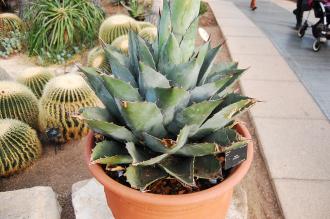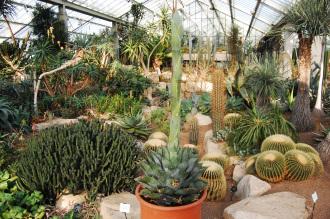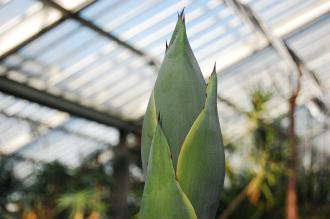
Agave parrasana (16/01/2016, Kew Gardens, London)
Position: Full sun
Flowering period: Summer (After approximately 15 years)
Soil: Moist, well drained
Eventual Height: 60cm (flower spike 6m)
Eventual Spread: 60cm
Hardiness: 8b, 9a, 9b, 10a, 10b
Family: Asparagaceae
Sub Family: Agavoideae
Agave parrasana is a slow growing, evergreen, rosette forming shrub. Its fleshy grey/ green leaves are broadly strap shaped with spiny margins, up to 40cm long, 20cm broad, with terminal spins. Its leaves are arranged in a rosette. Its yellow flowers appear at the top of a tall, branched flowering stalk . Each plant flowers once, usually after 15 years, after flowering it dies. It produces rhizome like offsets which helps the slow spread of this plant. Its root system is shallow and fibrous.

Agave parrasana Flower Spike (16/01/2016, Kew Gardens, London)
Agave parrasana, commonly known as the Cabbage Head Agave, is native to the Mexico/ USA border region. In its native habitat it grows on limestone soils in mountainous regions.
The etymological root of the binomial name Agave is derived from Greek mythology being the daughter of Cadmus, who supposedly founded the city of Thebes. Parrasana is derived from the Latin meaning ‘from Sierra de Parras, Mexico’.
The landscape architect may find Agave parrasana useful as a dramatic specimen plant suitable for xeriscaping. This plant is suitable for growing as a pot plant. Once established this plant is drought tolerant.

Agave parrasana Flower Bud (16/01/2016, Kew Gardens, London)
Ecologically, Agave parrasana flowers are attractive to nectar loving birds and pollinating insects.
Agave parrasana prefers moist, well-drained soils. It tolerates most pH of soil. It will not tolerate wet soils.
Agave parrasana requires little maintenance.

Landscape Architecture

